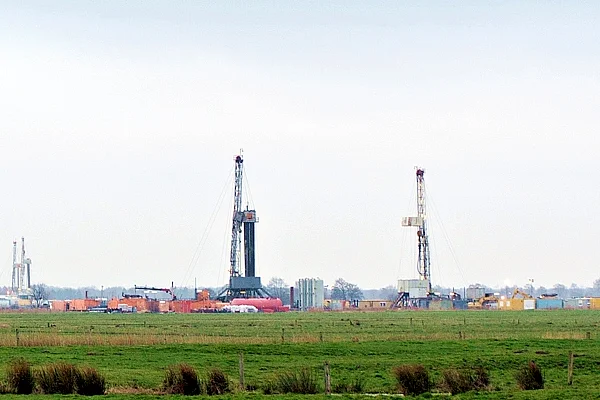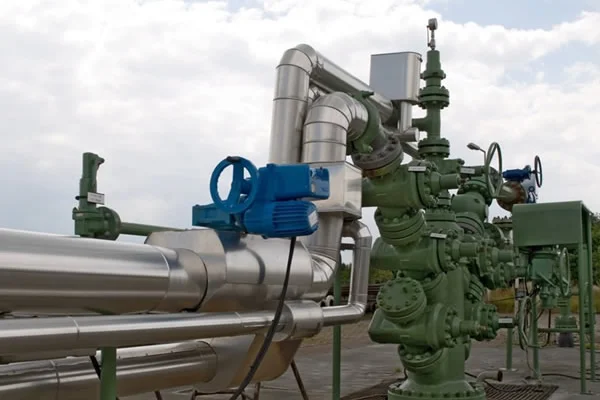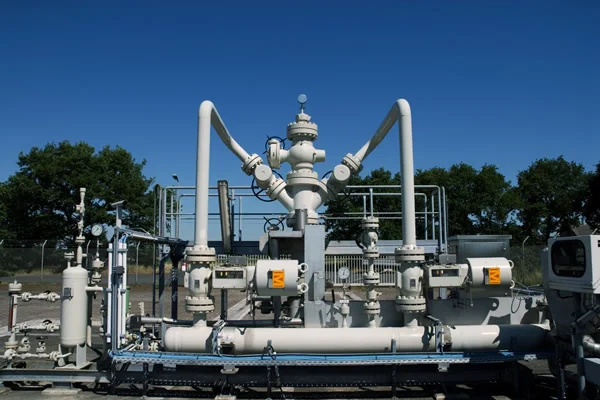From derrick to cavern head
What's being done in Etzel
The development of a cavern in Etzel takes about three years: First, the site is investigated.
This is done after intensive geoscientific analyses. Only when there is a green light for cavern construction will the site be built, the rig erected and drilled.
Learn more
Drilling
The drilling is necessary to open up new cavern sites in the depths of the salt dome. The drilling operation takes about two months. As soon as a cavern borehole is completed, the cavern head is erected on site and connected to the central operating facility via underground pipelines.
The cavern can then begin to be flushed out, the so-called brine operation. This lasts two to three years, depending on the cavern size.
The cavern sites are fenced off and often surrounded by typical local vegetation so that they are hardly noticeable in the landscape.
The central operating site is the heart of the cavern facility. From there, the caverns are operated and monitored via the existing infrastructure.
The construction of a drilling site and the sinking of a borehole are basically the first steps in any cavern construction project. Modern directional drilling technology makes it possible to develop several caverns at once from one large drilling site.
The use of directional drilling technology means that the cavern borehole is not drilled vertically downwards, but is deflected into the salt in an S-shaped course with a horizontal offset of up to 300 meters from the drilling starting point.
The advantage: Instead of many individual cavern sites, each with its own infrastructure on the surface, these can now be bundled on so-called cluster sites with up to seven caverns, i.e. one vertical cavern well in the center and six other deflected wells evenly spaced around it.
Through the derrick, the drill bit is driven through the rock layers of the overburden until it encounters the salt rock. Two pipe tours are installed one after the other in the borehole and each is cemented to the outside. The cavern head will later be mounted on this double-walled casing at the earth's surface once drilling is completed. Initially, drilling will continue in the salt to the planned final depth.
After the salt quality has been found to be good by the geologists, two pipe runs of different diameters are installed for brine operation and suspended in the cavern head. The drilling rig will then be dismantled.
After installation of the brine pipe combination in the borehole and the piping connection to the main operating station, brine operation can begin.
In the direct brine process, fresh water is pumped into the borehole through the inner string. The water exits at the pipe shoe into the open borehole and gradually dissolves the salt. A concentrated salt solution (brine) is formed, which is removed upward through the outer string.
The brine is conveyed from the cavern head via the field pipeline system to the main operating site, where it is cleaned in a separator before being discharged into the North Sea through the long-distance brine pipeline at Wilhelmshaven.
The brine discharge into the sea is absolutely environmentally compatible and is constantly monitored by the authorities.
After nine months, the main brine phase begins, during which the brine process is switched from a direct to an indirect mode. The fresh water is now pumped into the cavern via the annular space between the inner and outer brine pipe tours, and the brine rises via the inner brine pipe.
By changing the brine mode, the shape development of the cavern can be controlled, among other things. The cavity development of the cavern is controlled at regular intervals by surveying. A thin measuring probe is inserted via a cable through the borehole into the cavern and the cavity is measured in detail using ultrasound technology.
After two to three years, so much salt has been dissolved and concentrated brine transported out of the cavern that a cavity up to 60 meters wide and 300 - 500 meters high has been created.
The useful life of the created cavern is up to 100 years.
After completion of the brine process, which can take about 30 months on average for a cavern, the internal piping is converted for storage operation.
In oil caverns, the pumped-in crude oil displaces the brine. In turn, displacement of the crude oil is practiced using seawater (or brine).
In the case of gas caverns, the brine remaining in the cavern is removed by gas injection during the so-called initial filling. The pipe string necessary for the removal of the brine is pulled out by means of a so-called snubbing process and the cavern is then ready for operation. The gas is injected and withdrawn via compressors.
Status of field development since 2006
- 53 cavern sites built (6 single sites; 10 manifold sites, 1 more under construction, 1 in planning)
- 50 boreholes with approx. 80,000 drilling meters drilled
- Pipeline connection of 6 individual caverns and 9 manifolds
- 2 gas caverns were completed and handed over to the customer in 2017
- Parallel brine operation of up to 25 caverns possible
- Conversion project of 10 former oil caverns to gas operation completed, gas burst filling carried out
- Construction of Etzel North and South infrastructure, acquisition of rights to real estate largely completed
- Implementation of compensation and replacement measures
- Supplementary protection measures for field pipelines in Etzel cavern field implemented
- From 2012 to 2020, a programme was carried out to secure the long-term existence of the pipelines in the South Field area; 1st phase of construction measures was completed in 2014; construction measures for 2nd phase of pipeline renewal in the South Field were completed in 2019; construction measures for construction phases 3 and 4 of the South Field renovation were completed on schedule in 2020
- In 2022, the 1st phase of the hydrogen pilot project "H2CAST Etzel" started; Etzel will be "H2-ready" by the end of 2025


